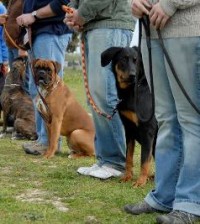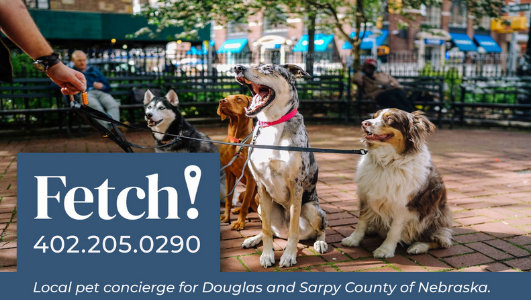- Do you subscribe to Dharma Dog Training’s Newsletter? You should.
- A Unique Campaign from The Humane Society of the United States
- Rabid bats in Omaha- Stay safe, prepared with these tips
- Springtime Activities in Omaha
- Mill Dog Monthly from Bailing Out Benji
- World Spay Day, Legislative Alert in Nebraska
- Attend the Nebraska Rescue Council’s monthly meeting this Saturday
- Five Hard-to-Ignore Reasons to Adopt!
- Paws in Pink to Benefit Breast Cancer Foundation
- VCA, Inc. Acquires MidWest Vet Specialists from Kansas State University
Get help training your dogs
Some dogs just don’t mind their manners. And even if you are the most experienced dog owner, you may have some trouble getting Fido to behave in the way you want him to.
Luckily, there are a ton of resources out there that can aid you in changing your pooch’s behavior. In Omaha, there are dozens of places that are here to help. Whether you want your dog to go for walks without pulling your arm off, keep them from barking, keeping them from being aggressive or responsive towards people and other dogs, or get potty trained, help is surely just around the corner.
From the web, we’ve found a few tips on a handful of problems you may be facing. Take a look and maybe you can start the training process before consulting professionals:
On barking: The Humane Society’s national Web site indicates that it is important for you to know why your dog is always barking before you attempt to get them to stop. Here’s a list of reasons your pup may be talking too much:
Attention/Demand: Your dog may want to eat, go outside, or your undivided attention.
Boredom/Frustration: Your dog may have been left outside day and night, or confined to one room for a long period of time.
Fear: Your dog may be afraid of objects, people, places, other animals, or loud noises such as thunder and fireworks.
Tip: Your dog’s posture can tell you if he’s barking out of fear. Typically his ears are back, and his tail is held low.
Territoriality/Protectiveness: Your dog is barking in the presence of “intruders,” which may include people and other dogs in adjacent yards.
Tip: If your dog is being territorial, his posture appears threatening with his tail held high and his ears up and forward.
Playfulness/Excitement: Your dog may be overly playful and excited when greeting people.
Health Issues: Your dog may have Canine Cognitive Dysfunction or deafness, causing him to bark because he’s unable to hear himself bark.
Find out why the barking is consistent and unstoppable first, then your job will be easier. Results don’t happen overnight, the site says, but knowing what you are fixing is the first step in success.
On going for walks in an orderly manner: pets.webmd.com has a great (but very lengthy) article that tells you how to get your dog to walk the way he or she should. Since it’s so long, we’ll just give you some highlights:
- Keep training sessions frequent, short and fun.
- Play a bit before going out and about. If you can tire your pup out a little before walking, he or she will be more likely to walk calmly.
- Make sure to reward your dog with treats when sessions go well (both during and after).
- Walk at a brisk pace. If you are moving along steadily, your dog will have fewer opportunities to get distracted.
- Make sure your dog is relatively calm before walking. The site suggests that you stand by the door with the leash and observe your dog before hooking them up. If he or she is bouncing off the walls, simply wait until the energy burst has subsided- then have at it.
On biting, nipping: One of the most widely-known trainers in the world is Cesar Millan. He’s got books, television shows, and more that provide advice on how to train your dogs. In this article, he explains why dogs bite and gives some tips on how to get them to stop. Again, it’s quite long, so here are some highlights:
Dogs often bite because they are protective or possessive. If he or she doesn’t like someone or something near them, they’re liable to snap. Dogs also bite out of fear. Other dogs, nefarious-looking people, and more can spook dogs, causing them to attack. You may notice that your dog gets more liberal with his or her jaws as they grow older. Any sort of medical condition or pain can make dogs irritable and likely to bite. Female dogs have maternal instincts that may cause them to get aggressive, too. Whatever the case may be for your dog, Cesar offers these tips on how to put a stop to the nipping:
- Spay or neuter your dog. This will almost always make them less aggressive.
- Exercise and play with your dog in a fun and friendly way to build rapport. The relationship between the dog and humans will benefit from frequent play and exercise.
- Do your best to eliminate anxious situations for your dog. If you commonly walk by a house with a loud, snarly dog, find a new route. Avoid anxiety and your dog will likely calm down.
- Don’t try to socialize too much, too fast. Too many stressors, sniffers, and unfamiliarities can bring out that anxiety that turns to aggressiveness.
There are many common problems when it comes to dog behavior, and the above resources are just a few available online. Working with your dog may help; it may not. If you are unsuccessful or don’t have the time to consistently work on behavior, seek professional help. Like we said earlier, there are dozens of outlets for you here in Omaha. Make sure to check out our sponsors listed in our Directory. These are some of the greatest trainers around. The Nebraska Humane Society has academies that are highly recommended- never forget about them and all their services as they are the leaders in our pet community.
Have questions about something not covered here? Use the CONTACT US form on our homepage and we’ll seek help from one of many area experts.
Overall, nurturing you dog from birth is probably the single greatest thing you can do to control behavior and raise a nice pup. Love them, give them attention, play with them and make sure to get them some exercise. All these simple things can help tremendously in the long run.
Click around the web and see which place would be best for you and your pup to get educated. Don’t forget the partners we have listed in our Directory– they are some of the best around.
Photo credit: lovedogtraining.com
Related Posts
Latest News
-
Join Us at Pick A Pooch 2025: A Fun-Filled Weekend for the Whole Family
A Fun-Filled Weekend for Pet Lovers and Families Alike Mark...
- Posted 1 year ago
- 0
-
Beardmore Presenting Sponsor At This Years Pick-A-Pooch event
🐾 We are thrilled to announce that Beardmore Subaru is...
- Posted 4 weeks ago
- 0
-
How Having A Pet Can Change Your Life
Having a pet can open your heart in ways that...
- Posted 2 months ago
- 0
-
How To Improve The Life Of Your Senior Pet
Do you have an elderly fur baby and want to...
- Posted 3 months ago
- 0
-
Springtime Activities To Enjoy With Your Furry Friends
Are you preparing for warmer weather and want some ideas...
- Posted 4 months ago
- 0
-
Pros And Cons Of Microchipping Your Pets
Have you considered whether your pets should be microchipped and...
- Posted 5 months ago
- 0
-
The Best New Fun Toys For Dogs And Cats
The Best New Fun Toys For Dogs And Cats Did...
- Posted 5 months ago
- 0
-
Heartfelt Ways To Show Your Pet You Love Them
Did you know there are more ways to show your...
- Posted 6 months ago
- 0























You must be logged in to post a comment Login